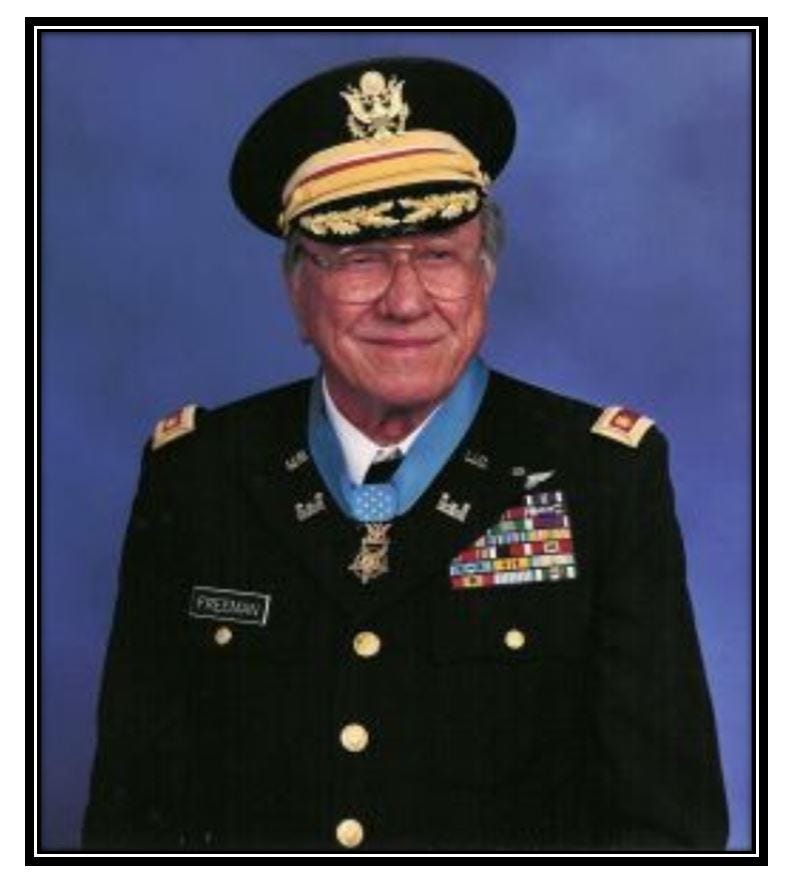Medal of Honor Monday: Ed Freeman
Freeman knew he had to go. “I put ‘em in there,” he explained. “And it’s a soldier's trust. The Army had assigned me a helicopter—that was a wonderful tool. And I could make it talk.”
On this day in 1965, a hero engages in an action that would earn him the Medal of Honor. At 6 feet, 4 inches, Ed Freeman was initially deemed “too tall” to be an aviator.
He was accepted into flight school only when the Army—desperate for pilots—changed the height requirement in 1955.
Fortunately, U.S. Army Captain Freeman had thousands of flight hours under his belt by the time he got to Vietnam, but he would need every last ounce of skill that he possessed to get through his mission on November 14, 1965.
Freeman was then serving with the 229th Assault Helicopter Battalion, which was tasked with inserting troops into a landing zone near the Ia Drang River. It was the first day of the first major battle between American and North Vietnamese troops. Freeman was second-in-command of his 16-helicopter lift unit.
“We made four lifts into there without receiving a round of fire,” Freeman later described, “[and] I thought: another cakewalk here. On the fifth lift they cut us in two. . . . three regiments come off the side of that hill—they were dug in.”
All four men aboard the helicopter were wounded, including Freeman. He returned to the staging area to discover helicopter operations shut down. But they couldn’t stay that way: The battle on the ground was too intense. Someone was going to have to go back.
Freeman volunteered. He surely didn’t expect to survive such a mission, but he knew he had to go. “I put ‘em in there,” he explained. “And it’s a soldier's trust. The Army had assigned me a helicopter—that was a wonderful tool. And I could make it talk.”
Freeman flew his unarmed helicopter back and forth for hours. He delivered needed ammunition, water, and medical supplies. He picked up wounded soldiers.
Amazingly, throughout this time, his landing zone was only 100 to 200 meters from the heaviest fighting.
“Captain Freeman flew 14 separate rescue missions,” his citation notes, “providing life-saving evacuation of an estimated 30 seriously wounded soldiers—some of whom would not have survived had he not acted.”
Miraculously, Freeman survived, too. Perhaps you won’t be surprised to hear that this veteran of three wars retired just a few years later? He began flying helicopters for the Department of the Interior instead. Captain Freeman had been nominated for the Medal of Honor, but not in time for a statutory deadline.
Fortunately, Congress removed the deadline, and Freeman finally received his Medal of Honor in 2001. “I can’t hardly describe the feeling that I had when he hung that medal and took two paces back and saluted,” Freeman said, “the President of the United States.”
Maybe just as memorable? A few months later, Freeman was at the White House for the premiere of a movie about Ia Drang. As he left the theater, the President saw him and saluted again: “Good job, Too Tall.”
Sources can always be found on my website, here.





Thank you for your courageous actions on this day in 1965 Captain Ed Freeman. You saved many seriously wounded men while in eminent danger yourself and while already having been wounded yourself. Thank you Sir. God bless you.
Thank you Tara for another MOH Monday
WOW! A brave man dedicated to saving "His Men" and not thinking of his own life in the process. What greater love than a man lay down his own life for a friend? A real 'man's man' and marked as a true MoH qualified hero...without time limits!!